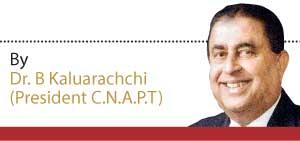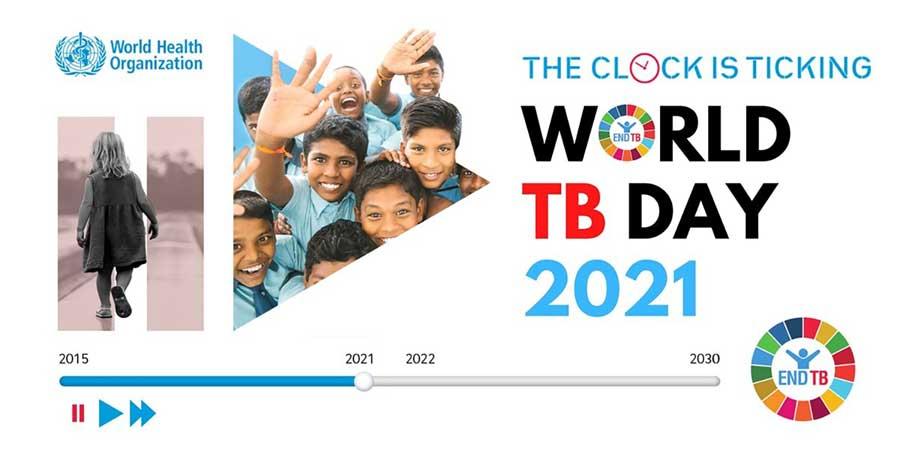24 Mar 2021 - {{hitsCtrl.values.hits}}

It is said that one third of the world’s population are infected by TB
Despite its eradication some time ago, Tuberculosis is proving to be the scourge of the 21st Century as it appears to raise its head again with a vengeance.
to raise its head again with a vengeance.
TB as it is commonly known is posing a serious health hazard in the industrialized world while in the developing world it is out of control, according to several health officials.
World Health Organization (WHO) Officials, who have declared a global emergency, said statistics show that historically more people died of the lung disease in 1995 than in any other year. That year, TB claimed the lives of nearly three million people, surpassing even the worst years of the epidemic in the 1900s, when an estimated 2.1 million people died annually.
Ninety five per cent of the deaths continue to be in the developing world. However, industrialized nations, which for decades thought they had rid themselves of the disease, are also seeing a resurgence. The number of TB cases is on the rise in Denmark, Norway, the Netherlands, Italy, Britain, the US and many other industrialized countries, say WHO officials, who warn the crisis will grow unless immediate action is taken.
While the West basked in a false sense of security, TB raged on in the poorer countries of the developing world and unsuspectingly rode on the movements of mass migration, to turn up on the doorsteps of the wealthy nations again.
Health officials warn that the emergence of drug-resistant strains of TB threaten to make the disease incurable, as it was before the discovery of antibiotics in 1944. That raises the spectre of a return to an age when diagnosis of TB was tantamount to a death sentence.

Tuberculosis, global threat
Tuberculosis is an epidemic assumed by most people to be a thing of the past. It is still increasing globally and it’s back with a vengeance and once again posing a serious threat to the developed world. It is said that 1/3 of the world’s population are infected with TB and someone in the world is newly infected every second. Left untreated a person who develops active TB will infect an average of 10 to 15 others every year. Effective drugs that can cure active TB was made available for more than 50 years, yet nearly 2,000,000 people a year still die of the disease.
Tuberculosis, a highly infectious disease which attacks the lungs, has in fact been completely curable for almost 50 years with a simple and relatively inexpensive course of antibiotics. But poorly implemented treatment programmes and incomplete antibiotics therapy have given rise to the new killer strains. You may be successful in diagnosing a patient with TB, but unless you can follow that through with the right therapy for at least six months, you will end up with pockets of resistance to the disease.
"Why cannot Tuberculosis be conquered easily? It is due to the low priority tuberculosis is given by health policy makers. In many low to middle income countries less than 1% of the annual health budget is allocated for Tuberculosis -- unbelievable but true"
Research estimates that already, at least 50 million people worldwide are infected with strains that are resistant to at least one of the four common antibiotics used to treat TB. A staggering one-third of the world’s entire population is now infected with the TB bacillus. Over the next decade, it is estimated that 300 million more people will become infected while 90 million will develop the disease and 30 million people will die from it.
TB whose symptoms include coughing up blood, raging fever and severe loss of weight, attacks the victims’ lungs gradually destroying living tissue. As their lungs are consumed, the sick patients die through asphyxia by virtually drowning in their own blood.
Only a relatively small percentage of people who are infected with the bacteria will actually develop the disease. TB is spread through the air easily when an infected person sneezes, coughs, even talks, suspending the bacilli in the air which can in turn be inhaled by others.
In fact, only people with active TB can infect others. But unhygienic living conditions and a poor diet – all problems associated with immigrants in a new country – can quickly turn dormant TB into the disease itself. “Immigrants often live in undesirable conditions and live on a poor diet, and this in terms lowers their immune defense system, and the disease erupts, said Dr. Arosa.
If countries have been slow to react to the danger of the spread of TB, airlines could unwittingly be putting their passengers at risk. There have been some recent documented cases of air travellers who have caught TB from fellow airline passengers.
Another high-risk segment of the population include people with the Human Immunodeficiency Virus (HIV), the causative agent and precursor of AIDS (Acquired immune Deficiency Syndromes). The HIV virus lowers the body’s defenses against opportunistic disease such as TB, making the victim much more vulnerable to infection.
If you become infected with HIV, your immune system is depressed and that is when, if you are carrying around the TB bacteria in your system, you are likely to develop the disease. People with HIV can also, more easily catch TB infection from others who already have it.
"World Health Organization (WHO) Officials, who have declared a global emergency, said statistics show that historically more people died of the lung disease in 1995 than in any other year. That year, TB claimed the lives of nearly three million people"
Increasingly the two killer diseases – AIDS and TB go hand-in-hand. One-third of people who die of Aids worldwide are actually dying of TB, say health officials. It is the leading killer of HIV-positive people in the world. This is especially a problem in Asia and Africa, though we have also seen TB spreading on HIV wards in the industrialized world.
Of the 14 million people known to be infected with HIV in 1994, the latest year for which figures are available, 5.6 million were also believed to be infected with TB. The deadly partnership between AIDS and TB is taking a particularly heavy toll on parts of the developing world.
Why cannot Tuberculosis be conquered easily? It is due to the low priority tuberculosis is given by health policy makers. In many low to middle income countries less than 1% of the annual health budget is allocated for Tuberculosis -- unbelievable but true. Why? Because TB is something to be swept under the carpet, covered up and its existence ignored. The tragic consequence is that because of inadequate funding, inefficient TB control programmes have actually led to a worsening of the world’s TB situation. This is because the patients are not cured but do not die of the disease, either leading to a pool of inadequately or improperly treated patients; Disseminating multi drug resistant TB in the community. In other words a poor TB control programme, will contribute to many patients dying of the disease though there will be no half treated half dead patients and therefore these people will continue to disseminate the disease to healthy people. Also, multi drug resistant TB is entirely man made by doctors, the patients themselves and the drug companies. Doctors because they may prescribe drugs in the wrong dosage or combinations, or because, the patient may have to buy all the drugs for the prescribed period, in addition to paying the consultant’s fee. The drug companies, because they may produce poor quality drugs which may not have the correct quantity of the drug in them.
However, all is not gloomy. It has been shown conclusively in countries poorer than Sri Lanka such as Nepal and Bangladesh, (with per capita GNPs of around US$200 compared to a per capita GNP of US $840 for Sri Lanka) that more than 90% of tuberculosis patients can be cured and the emergence of multidrug-resistant tuberculosis controlled if the treatment of Tuberculosis patient is completely supervised in other words, someone (Nurse, health volunteer worker public health worker, a relative) actually watches the patient swallowing the drug. Tuberculosis patients (or for the matter, any patient) have the bad habit of forgetting to take their drugs when they feel better. The very efficacy of modern anti-tuberculosis drugs is in a way a disadvantage, because patients feel normal too soon, leading them to forget to take their medication or take it irregularly. Directly supervised treatment circumvents this hurdle and has now been shown to be the only way rampant tuberculosis can be controlled. This method of treatment circumvents this hurdle and has now been shown to be the only way T.B. can be controlled. This method of treatment has been given the acronym DOTS – directly observed treatment short course –and has been proven to dramatically improve cure rates and reduce the incidents of multi-drug resistant tuberculosis in countries as diverse as the Philippines, Peru, China Bangladesh, Nepal, Thailand, Cambodia, Ghana, Tanzania and Indonesia.
Compared to other South Asian Countries Sri Lanka is far ahead in terms of quality of life, life expectancy, literacy, maternal mortality and infant mortality. This is a constant source of amazement to developed countries like Japan, who wonder how we can maintain such indices comparable to a developed country in spite of other factors such as the 30-year-old war. The answer is, of course the standard of literacy and education of the population and the solid health infrastructure.
It would be tragic indeed if the tuberculosis situation in this country was allowed to deteriorate in spite of possessing such a proud record in health care.
As such, educating the public is the most important part aspect of TB eradication. Ceylon National Association for the Prevention of Tuberculosis (CNAPT) has been in the forefront of the campaign for educating the people in Sri Lanka on TB Prevention. Over the last 73 years it has worked in partnership with the Ministry of Health and a diverse range of civic society partners in promoting knowledge and understanding on the disease amongst the vulnerable section of the population and improving their access to proper medical care .Last year the CNAPT with financial assistance received from the Global Fund for Aids TB and Malaria (GFATM), sponsored a knowledge, Attitude and Practice behavior that stand against the national efforts at eradication of TB programme. TB, the study undertaken in collaboration with the Medical personnel of the Respiratory Disease Control Programme of the Ministry of Health was assisted by the Centre for Social Survey and the University of Sri Jayewardenepura. CNAPT has also started a health education programme on TB with the intention of disseminating the knowledge on TB, its spread, its prevention and management and to let the public know where to get the help and assistance they require. The primary target groups of this education campaign launched by the CNAPT are the school teachers aimed at taking advantage of their strategic position and spreading the message through their pupils to the society at large.
27 Nov 2024 10 minute ago
27 Nov 2024 49 minute ago
27 Nov 2024 1 hours ago
27 Nov 2024 1 hours ago
27 Nov 2024 1 hours ago